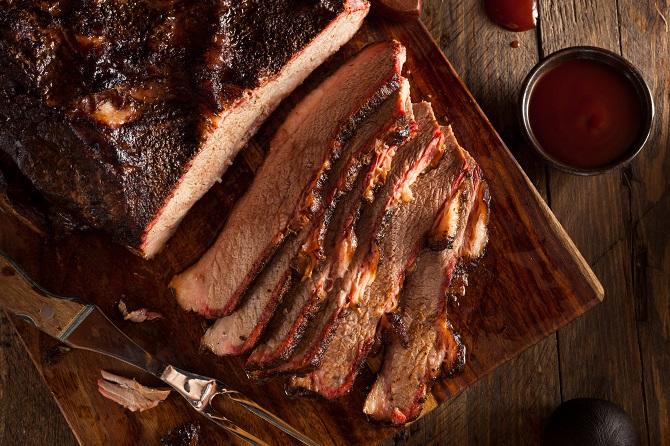Blog
How to Smoke the Best Barbecue Brisket Of Your Life
Juicy, fatty, smoky, crunchy, and oh so heavenly.
Learn everything you need to know about making perfect BBQ brisket, courtesy of Burt Bakman, who would never call himself a pitmaster (but definitely is a pro).
If you’re a home cook seeking advice on how to cook the perfect barbecuebrisket, Burt Bakman is the best person to ask–with one important caveat. Before Bakman launched Slab BBQ, the critically adored smoked meatpurveyor on Los Angeles’s trendy West 3rd Street, he was a real estate agent with a hobby. Actually, it was more of an obsession—logging hundreds of hours with plenty of sleepless nights cooking up Texas-style barbecue in his backyard. “Some people want to go to culinary school, but all they need to do is keep trying and fail forward,” says Bakman.
After earning raves from friends and family, Bakman decided to share his meaty marvels with the general public, and Trudy’s Underground Barbecue was born. Suddenly, in-the-know Angelenos were swarming Bakman’s home for a taste of some of the best BBQ on the west coast. While his ribs (pork and beef) have a devoted following, Bakman’s brisket has become the stuff of legend: juicy, fatty, smoky, crunchy, and oh so heavenly.
And this where we get to that caveat. Although Bakman seems to have mastered the art of the brisket, he will never cop to that. “There’s no master of anything,” he implores. “Pitmaster is a horrible term. The pit is the master.”
Still, it’s hard to deny Bakman isn’t at the very least close to achieving his barbecue black belt. Below, he shares some of the tips and tricks that he’s learned over the years. But if it’s the “perfect” brisket you seek, consider tempering your expectations. “I’m on the pursuit of the perfect brisket, myself,” Bakman admits. “There’s always more to do.”
Find the Right Smoker
Barbecue is a time-consuming affair requiring hours, if not days, to properly cook your meat. But if you’re looking for a shortcut, Bakman suggests going with a Traeger plug-in smoker. Simply add some pellets (wood chips and dust that are compressed into pills), throw on the protein, punch in the temperature, and you’re good to go–set it and forget it. Sure, the finished product will be great, but it’s essentially the Rosie Ruiz of cooking, stripping away the blood, sweat, and tears that Bakman views as integral to the barbecue experience. “I understand that some people don’t want the challenge and don’t have the time,” he says. “Not for me.”
For a more hands-on approach to smoking meats, Bakman recommends purchasing a ceramic grill from Big Green Egg or Kamado Joe. These grill/oven/smoker hybrids are fueled by lump hardwood charcoal and are notable for maintaining temperature control particularly at a low heat. Be warned: This is a costly investment, but while you may be tempted to settle for a basic model, Bakman recommends splurging on a size upgrade, especially considering the time commitment that will go into preparing each batch of meat. “Instead of doing one brisket at a time, you’ll be able to do two at a time,” he says. “That’s a big difference for your parties…The whole purpose of barbecue is to share a meal with your friends and create memories. That’s what cooking is all about.”
Bringing Home the Brisket
When it comes to barbecue, you’re going to want to go whole brisket. Also known as a full packer, it includes both the fatty point (the top muscle) and the leaner flat. Most supermarket brisket is exclusively the flat cut so be sure to find a butcher that offers the full package.
Bakman’s checklist for selecting an exceptional full packer starts with ensuring that the brisket fits in your smoker. Next, check that it has a solid cap of fat on top. “You lose a lot of that fat when it renders into the meat,” says Bakman. “If you cut that fat off, nothing will protect the meat for the duration that you need.” Too much fat, however, is also no bueno. “You won’t be able to render it, and you’re not going to have a good color on the brisket after it’s smoked,” he adds. Basically, about a quarter of an inch of fat is your sweet spot. Overall, the brisket should have a sleek, aerodynamic shape.
Finally, Bakman recommends picking up the brisket and folding in half. “You want it to be pliable. That shows you that you have good fat in there.”
Here’s the Rub
No, surprise, but If you’re seeking the recipe for the “perfect” rub, look elsewhere. “There is no ‘one rub,’” Bakman emphasizes. “People experience salt and spices and seasonings differently. There’s no one way to please everybody.”
While some barbecue buffs swear by cumin or coffee grounds, Bakman’s rub keeps things basic: half salt, half pepper. Specifically, he uses a blend of kosher and Lawry’s seasoned salt along with coarse and very coarse pepper (16 and 32 mesh to be exact). According to Bakman, the grind of the pepper will help the brisket’s signature crust (a.k.a. bark) hold onto the smoke.
Bakman recommends sprinkling the rub on (“don’t rub it in”) and making sure the brisket is well coated. Though there is a contingency that believes letting the rub settle in overnight benefits the bark, he prefers to apply it immediately before the brisket is ready to cook. “I always worry that if they rest overnight, the salt will extract the moisture out of the brisket, which I like to avoid.”
Along with sprinkling the salt and pepper directly onto the meat, Bakman will, on occasion, take inspiration from Texas barbecue and use a binder, slathering the brisket with mustard watered down with apple cider vinegar, water, or pickle juice providing an added “bite.”
Time to Cook
Time, of course, is the key word here and in order to prevent you from wasting any of it, Bakman offers an important tip: Take notes! “Have diligent notes on your process so you know what made a difference. [If] you don’t have notes and you don’t know what went wrong, you’re risking doing the same thing again and wasting 18 hours of your life for nothing.”
Along with a pen and paper, you’ll also want to add wood to your shopping list. No surprise, but just like virtually every aspect of barbecue, choosing the right variety is a point of contention. Bakman happens to be an oak guy. “It burns well. It’s dense enough to last longer than some other woods. The way it smells, that smoke will transport you to Texas right away.”
With the wood procured and the brisket rubbed down, add a bed of charcoal to the smoker, light it up, and let it burn until it’s all white. Bakman will then add pieces of wood, just enough to avoid choking the bed of coals. “You can imagine something out of a cartoon, thick white clouds billowing out–that’s not ideal,” he cautions. “When you have good clean heat, good clean fire, you’re not going to see the smoke.”
Once it’s time to put the brisket into the smoker, place it fat side up. When it comes to cooking time, prepare to allot about an hour per pound with the meat cooking at a temperature of around 250 degrees–slow and low.
About halfway into the cook when a dark, mahogany color on the brisket starts to take shape, Bakman recommends gently misting it with a mixture of apple cider vinegar and water and continuing the spritz every 45 minutes. This will not only remove some of the smoke ash that has settled on the meat, but it will also add some flavor and help form the bark.
Eventually the brisket will reach an internal temperature of 165 degrees and once that happens the mercury won’t budge for what seems like forever. Don’t panic! This a natural occurrence known as “the stall.” Though some people advise wrapping the brisket in foil at this stage (a move known as the “Texas crutch”), Bakman warns against that. “Once I wrap a brisket in foil, no more smoke is hitting it, he says. “The color that I’ve built up, the bark that I’ve built up is getting lost now because I’m steaming this brisket, which is something I don’t want to do.”
Resting (The Hardest Part) and Eating (The Best Part)
When the brisket hits an internal temperature of 203 degrees, it’s ready to be removed from the smoker and left to cool down to around 135 degrees. But don’t start setting the table just yet, this baby needs its slumber. In fact, Bakman suggests letting the brisket rest (tightly wrapped in butcher paper) for the amount of time it was cooked. “I believe that when you rest it for a long time you get a better color on your brisket,” he says.
While the brisket rests, Bakman leaves it on a sheet tray and then transfers it to a warming cabinet when it’s ready.
Now that it’s finally time to enjoy the meaty fruits of your labors, make sure you’re slicing the brisket properly. “If somebody wants lean, I cut straight from the front of the brisket, from the flat part from the end of it,” says Bakman. “Just cut across the brisket, about a pencil thickness. If somebody wants fatty, I’ll cut the brisket in half, right in the middle where the point is. For the point, you cut along the brisket, and for the flat, you cut across the brisket. If it’s done right, you’ll have nice color, you’ll have nice fat and juice, and it’s great.”
And if the brisket doesn’t meet expectations, that’s fine too. “There’s no right or wrong,” Bakman implores. “It’s just about doing it, cooking it, failing forward, spending time with your friends. Barbecue is a state of mind. It’s not a competition.”
Visual learner? Take a MasterClass on Texas Barbecue from Aaron Franklin, a fellow BBQ guru.
Fuente: chowhound.com

